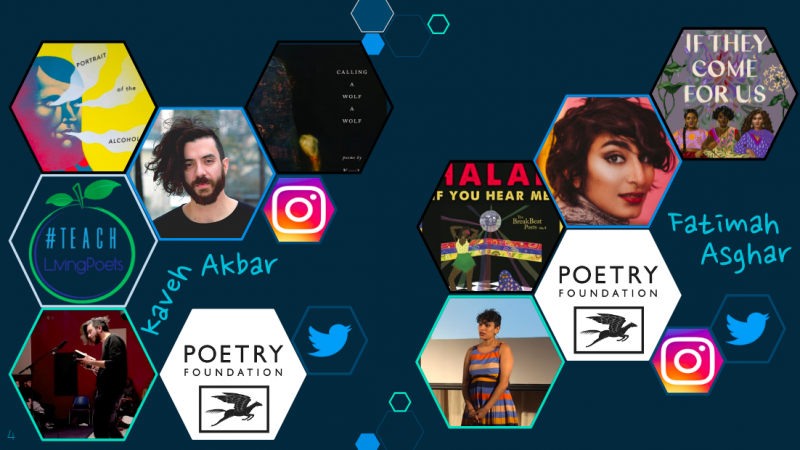Why is it important to teach living poets?
Smith: Not only does it help teachers rejuvenate their passion for teaching poetry, it helps the students in so many different ways. Back when, pre-#TeachLivingPoets, I admit I was one of the teachers who stuck pretty much to canonical poetry: Frost, Whitman, Dickinson. And not to say we should not teach those; I think we absolutely should. #TeachLivingPoets is not about closing the door on the canon whatsoever. It’s just about opening the door wider for more voices, more contemporary voices to come into our classroom space.
It finally offers a lot of students a chance to not only see themselves reflected in the work that they read, but to learn, too, often about others who are different than us. Because one of the main focuses of #TeachLivingPoets is to center Black poets, indigenous poets, poets with disabilities, poets in the LGBTQ+ community and these voices that have often just been missing from the canon.
What does that look like in practice in your classroom?
Smith: I used to be a teacher who would be up in the front of the room, sage-on-the-stage kind of deal and have students identify what is happening in a line, find the simile in the poem, and ask, ‘What do you think it all means?’ And really what that was doing was making my students not discover the poem for themselves, but to just try to identify the answer that they thought I wanted to hear. What has happened since I started teaching living poets is that I’ve really tried to focus the learning and make it student-centered.
What’s an example of that?
Smith: This teacher, Tia Miller, so kindly shared one of my favorite lessons, and you could do it in various different ways. But the way that I do it is you cut out all these hexagons and on each hexagon there’s a title of a poem. So say I teach a full collection, like Richard Blanco’s “How to Love a Country” or José Olivarez’s “Citizen Illegal” or Clint Smith‘s “Counting Descent.” So we have this whole collection of poems, and students have to put the hexagons together so that the sides that are touching indicate a connection that they see between those two poems.
And the discussions that they have when they do this — I’m not doing anything but walking around and just listening with my little teacher heart going gaga over what they’re saying.
I’d love to hear some of the memorable moments that have happened through those activities or other activities.
Smith: I had a student whose father died the summer before I had him in my senior year AP literature class. It was a really, really, really rough year. Then he got assigned a poem by Kaveh Akbar for this big project that they do for class. My student just felt a connection to Kaveh’s work and it felt like he read it, not with his eyes or his heart, but like, with his spirit, with his soul. I know this sounds so weird, but I’m telling you, this is what poetry can do. Right? It’s the power of poetry.
But the cool part was at the end of the year when Kaveh Akbar actually came to class for a poetry workshop visit and the student got to meet Kaveh and thank him in person just for his work and everything that his work did for him. Since meeting Kaveh, the student has gone on to college and is now a creative writing major and is writing all the time and performing at slams. You can’t do that with Emily Dickinson.
You also have a book now, “Teach Living Poets,” co-written by Lindsay Illich. And that’s also geared toward educators, right?
Smith: Yes, so it’s another resource that lays out the philosophy of why we teach living poets, and why we think it’s so important to teach living poets. But then the book does move into teaching specifically two different collections and lots of ideas for teaching individual poems, ideas for connecting with poets, whether that be through social media or through classroom visits, and becoming a connected educator into the world of poetry.
What challenges or hesitations have you noticed among other teachers who are incorporating living poets in their curriculum for the first time?
Smith: Trying something new is very hard and there aren’t a lot of resources out there. So that’s also why I started the website. It’s my favorite when teachers reach out to me and are just so excited about something that they tried. That’s the best. That’s what keeps me going and keeping up with this website is how it’s helping teachers.


